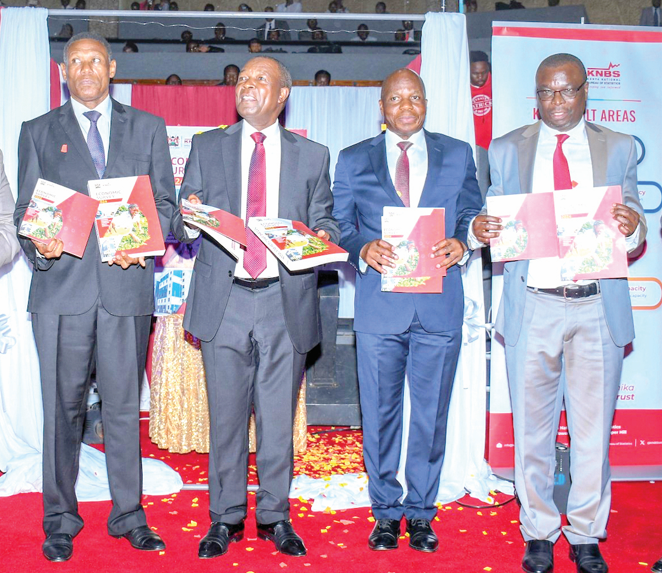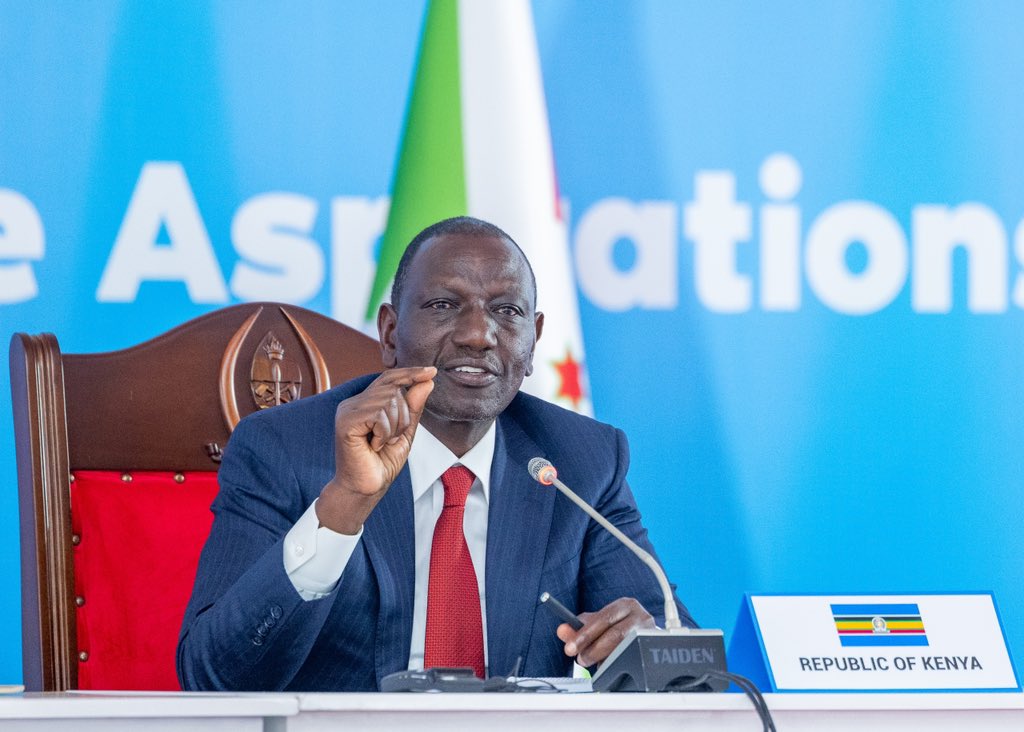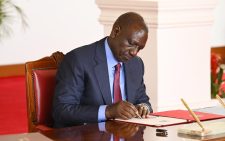Agriculture sector recovery grows economy by 5.6pc

The Gross Domestic Product (GDP) expanded by 5.6 per cent last year compared to 4.9 per cent in 2022 on the resurgent agriculture sector and despite a dip in trade.
The Economic Survey for 2024 shows during that period, global trade volume decelerated to 0.4 per cent compared to 5.2 per cent growth in 2022, mainly due to base effects from Covid-19 pandemic recovery, the dollar appreciation, and escalation of trade barriers.
According to the report by the Kenya National Bureau of Statistics (KNBS), the rate of inflation remained within set targets during the period under review, while the movement of Foreign Direct Investments (FDI) increased.
Kenya’s informal sector created most of new jobs and contributed 85 per cent of all the offerings reported in 2023.
“Overall, the nominal wage bill rose by seven per cent from Sh2,61 trillion in 2022 to Sh2.79 trillion in 2023. Nominal average earnings in the modern sector per person increased from Sh864,750.1 per annum in 2022 to Sh888,743.5 per annum in 2023. The annual inflation rate as measured by the Consumer Price Index (CPI) stood at 7.7 per cent in 2023,” said KNBS.
Kenya’s Net International Investment Position (IIP) — a key barometer of the country’s financial standing in terms of assets and liabilities with the rest of the world — saw a substantial increase as the country’s debt to foreign entities surged by 22.7 per cent, from Sh7.45 trillion to Sh9.139.9 trillion.
Economic performance
National Treasury Cabinet Secretary Njuguna Ndung’u hailed the report saying it aligns with the Bottom Up Economic Transformation Agenda proposed by the Kenya Kwanza government as it highlights economic performance and critical indicators.
However, the total value of minerals produced in Kenya declined by 4.3 per cent, dropping from Sh35.2 billion in 2022 to Sh33.7 billion in 2023 as firms like Base Titanium signalled exit from the Kwale mines. In total, the country witnessed a dip in cement consumption which decreased by 3.1 per cent to 9.2 million tonnes in 2023.
The survey says a rebound in the performance of the agriculture sector contributed to Kenya’s enhanced economic performance during the period under review. Other sub-sectors which recorded growth include forestry and fishing with the gross value added (GVA) of the three combining to surge by 6.5 per cent in 2023 compared to 1.5 per cent in 2022.
KNBS linked the growth to favourable weather conditions that characterized the better part of 2023.
The production of key food crops such as maize, beans and potatoes increased significantly during the year under review. However, production of main cash crops varied last year where the total quantity of tea produced increased to 570, 000 tonnes in 2023 up from 535,000 in 2022.
While the volume of coffee produced reduce by 6.2 per cent to 48,000 metric tonnes in 2022/23, the stronger dollar meant that farmers earned more from the exports including horticulture.
“Revenue generated from fresh horticulture exports increased rose by a million in one year from Sh146.1 billion in 2022 to Sh147 billion last year. The volume of cut flowers for export declined from 198,700 tonnes in 2022 to 73,500 tonnes last year,” the 2024 Economic Survey shows.
Cane production declined by 36.9 per cent from 8.8 million metric tonnes in 2022 to 5.6 million metric tonnes in 2023.
Milk sold rose by 6.9 per cent from 754.3 million litres in 2022 to 806.6 million litres last year. Fruits for export increased in volume from 44.1 per cent to 188,100 tonnes last year while the volume of exported vegetables doubled to 147,700.
Government expenditure on roads and the number of residential building projects under the State Department for Housing and Urban Development brought about substantial growth in the construction industry.
“The number of residential buildings completed by the department increased from 1,390 in 2022 to 3,357 in 2023. Additionally, the value of building plans approved by Nairobi City County (NCC) rose by 35.5 per cent to stand at Sh220.0 million in 2023 compared to Sh162.5 million recorded in 2022. Credit advanced to enterprises in the construction sector expanded by 8.7 per cent from Sh135.2 billion as of December 2022 to Sh147.1 billion as of December 2023,” KNBS Director General Macdonald Obudho said.
Transport and storage
KNBS data also show that the transportation and storage sector grew by 6.2 per cent in 2023 compared to a growth of 5.8 per cent in 2022. It attributed the growth to increased activities in transport via railway, port activities and air transportation.
Passenger and freight movements via Standard Gauge Railway (SGR) grew by 14.1 per cent and 7.3 per cent to 2,729 thousand passengers and 6.533 million tonnes, respectively, in 2023.
Railway revenue improved in 2023, with SGR cargo generating Sh14.685 billion, up by 7.3 per cent from the previous year while total passenger air traffic expanded by 19.2 per cent to 12.205 million passengers.
The volume of cargo traffic handled at the Port of Mombasa grew by 6.2 per cent from 33,880 thousand metric tonnes in 2022 to 35,978 thousand metric tonnes in 2023. This increase, KNBS said was driven by an increase in mobile money transfers and the growing demand for data-intensive services.
Mobile money transfer grew by 0.6 per cent to Sh7.95 billion in 2023. The total utilised bandwidth increased from 6.5 million Mbps in 2022 to 11.0 million Mbps in 2023 while the number of licenced internet service providers increased by 13.2 per cent to 533 in 2023.
“Total domestic call traffic grew by 13.4 per cent to 88.8 billion minutes while international outgoing call traffic increased by 1.7 per cent to 699.3 million minutes. Furthermore, the value of ICT equipment imports increased by 11.0 per cent to Sh61.3 billion in 2023 while exports expanded by 36.6 per cent to Sh3,178.1 million in the same period,” the survey reads.
Leather products
Manufacture of leather products top the non-food products at 21.7 per cent, basic metal at 10.1 per cent and plastic products at 16.2 per cent. In the hospitality industry, the accommodation and food service activities sector’s real GVA grew by 33.6 per cent in 2023 compared to the 26.8 per cent growth recorded in 2022.
The data agency linked the growth to tourism activities in 2023 such as the Africa Climate Summit and EU-Kenya Business Forum increased demand for hospitality services.
Similarly, visitor arrivals at the Jomo Kenyatta International Airport (JKIA) and Moi International Airport increased by 25.6 per cent in 2023 to stand at 1,635.3 thousand in 2023, up from 1,198.7 thousand in 2022. The number of occupied hotel bed nights increased to 8.63 million in 2023 from 7.009 million recorded in 2022. The number of international conferences increased by 9.0 per cent to 977 while the number of delegates rose by 50.7 per cent to 34,814 in 2023.










